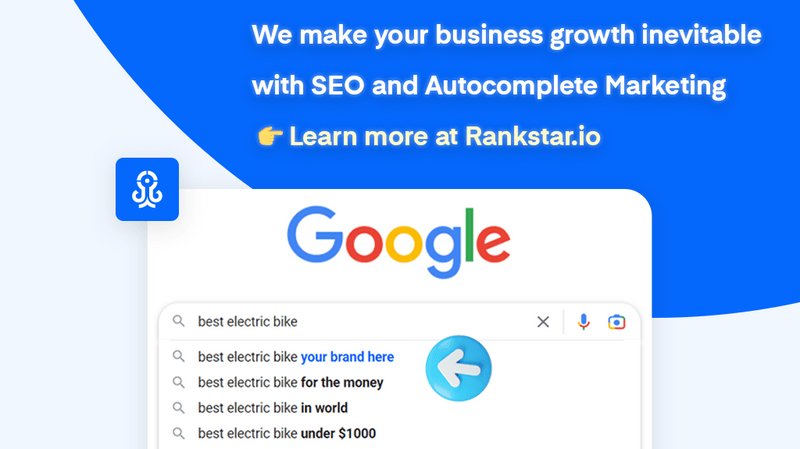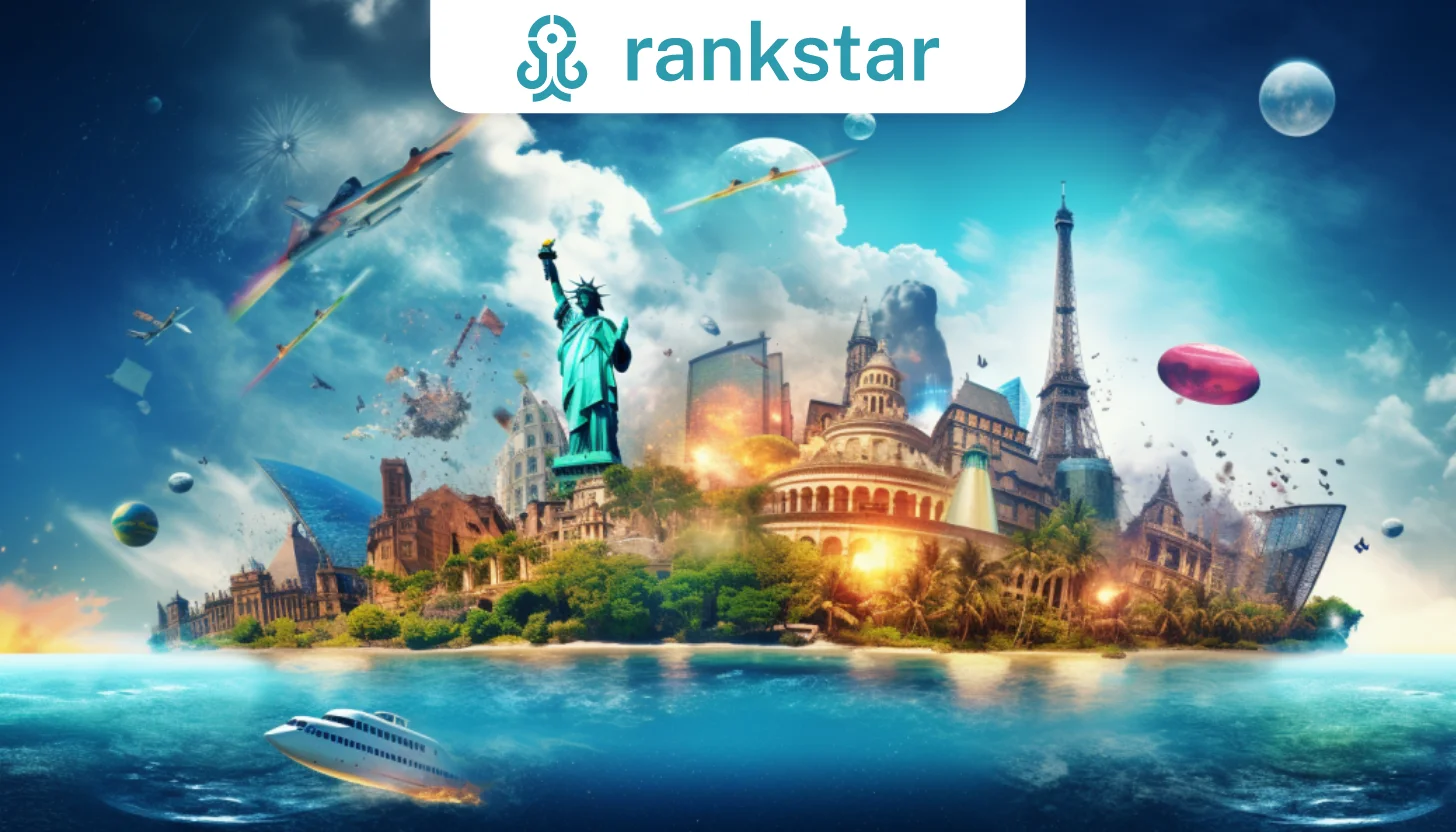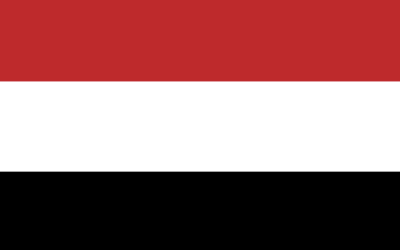Having the same significance for any other work in the service sector, search engine optimization (SEO) is an important tool for businesses in the travel and tourism industry.
SEO involves optimizing a website and content for search engine algorithms in order to improve visibility and ranking in search engine results pages (SERPs).
This can help businesses in the travel and tourism industry attract more visitors, as well as increase brand awareness and generate more leads and sales.
A specialized SEO agency for travel and tourism businesses can help develop and implement effective SEO strategies.
This article will discuss the benefits of SEO for travel and tourism businesses, as well as targeted keyword research and optimization, content marketing strategies, local SEO, user experience and website optimization, building authority and trust, and measuring SEO performance.
Contact Rankstar to leverage Your Travel And Tourism Organization’s Visibility on the Internet
→ Attract more visitors with the specialized SEO agency for travel and tourism!
Collaborate with Rankstar to enhance your online visibility, attract explorers, and elevate your travel business success. Elevate your visitor count and travel brand with Rankstar by your side. Start enticing more travelers today!
We are also here to propel your brand to the summit of Google’s search rankings, ensuring its outstanding prominence in both Google and Bing Autocomplete Suggestions and Autosuggest Removal when in need.

The Benefits of SEO for Travel and Tourism Businesses
The use of SEO has proven to be a highly effective tool in enhancing online visibility for travel businesses.
Through SEO practices, businesses can target specific types of visitors, driving qualified traffic to their site, thus increasing bookings.
Such practices can also help to improve the ranking of a website in major search engines, which can be a significant benefit for a travel business.
Enhancing Online Visibility for the Travel Business
By leveraging digital strategies, businesses in the travel industry can gain increased visibility and draw in a larger customer base. One of the most effective ways to do this is through search engine optimization (SEO).
SEO is a process of optimizing a website to attract more visitors from organic, or unpaid, search engine results. It can be used to:
- Boost visibility and traffic on a website
- Improve the website’s ranking in search engine results
- Enhance the user experience of the website by providing content that is useful and relevant
By implementing SEO correctly, businesses in the travel industry can achieve higher visibility and rankings in search engine results. This will help to draw in potential customers and increase the website’s overall traffic.
Additionally, SEO can help to improve the user experience of the website by providing content that is useful and relevant to the customer’s needs. This will help to build customer loyalty and create a positive online reputation for the business.
Driving Qualified Traffic and Increasing Bookings
Through the use of digital strategies, businesses in the travel industry can drive qualified traffic and increase bookings. These strategies include search engine optimization (SEO) techniques, such as optimizing website content to target specific search queries, building backlinks, and optimizing for local search.
Additionally, businesses can use content marketing techniques, such as creating content that is engaging and informative, and using social media to spread the word. By utilizing digital marketing tactics, businesses can increase their visibility and reach to drive more qualified traffic to their website and increase bookings.
Businesses in the travel industry can also use pay-per-click (PPC) advertising to drive qualified traffic to their website. PPC campaigns can be tailored to target specific audiences, and businesses can adjust their campaigns in real-time to improve results.
Additionally, businesses can use retargeting techniques to reach users who have previously visited their website, allowing them to reconnect with potential customers who are already interested in their services. By utilizing these digital strategies, businesses in the travel industry can improve their online visibility and drive more qualified traffic and increase bookings.
Targeted Keyword Research and Optimization for Travel and Tourism
The identification of high-conversion keywords for any given niche is a critical step in any SEO strategy for travel and tourism.
This process should take into account the different needs of tourists, as well as the specific goals of the business.
Once identified, keywords should be implemented strategically across both on-page and off-page SEO elements, such as titles, headings, alt tags, meta descriptions, as well as backlinks and other external links.
Identifying High-conversion Keywords for Your Niche
Identifying keywords that are likely to produce conversions is an important part of a successful marketing strategy in the travel and tourism industry. Part of the success of an SEO campaign relies on understanding which keywords will produce the most relevant and meaningful results for potential customers. High-conversion keywords are those that are more likely to result in website visits, purchases, and other desired actions.
When researching keywords for a travel and tourism website, it is important to create a list of search terms that are related to the services or products offered, as well as any special offerings or promotions that are available. This will help ensure that potential customers are able to find the website in search engine results.
In addition to researching related keywords, it is also important to consider the competition for each keyword. It is wise to avoid choosing keywords that are too competitive, as this can make it more difficult to rank high in search engine results.
SEO agencies can use tools such as Google AdWords Keyword Planner to research the competition for each keyword. This can help narrow down the list of potential keywords to those that are more likely to produce conversions. Additionally, the use of long-tail keywords is important, as these are more specific and easier to rank for than broad keywords.
Implementing Keywords Strategically in On-page and Off-page SEO
Once the relevant keywords have been identified, it is important to implement them strategically in both on-page and off-page search engine optimization (SEO) efforts in order to maximize the potential for successful results.
On-page SEO involves optimizing content and meta tags, such as titles, descriptions, and headings, using relevant keywords that will help the website rank higher in search engine results. Additionally, optimizing website speed and ensuring that the website is mobile-friendly are important on-page SEO considerations.
Off-page SEO, on the other hand, involves link-building efforts, such as building relationships with other websites and seeking out backlinks, as well as increasing the website’s visibility via social media and other marketing strategies.
To further optimize an SEO campaign for travel and tourism, some key strategies to consider include:
1) Optimizing the website for voice search, as this is becoming increasingly popular;
2) Optimizing images and videos, as this will help the website to stand out from the competition; and
3) Utilizing local SEO to reach tourists visiting a specific area.
By implementing these strategies, an SEO agency for travel and tourism can help a tourism business to attract more visitors.
Content Marketing Strategies to Attract More Visitors
When considering content marketing strategies to attract more visitors, there are several options to consider:
Creating engaging and informative blog posts and articles can be a great way to increase traffic to a website. Writing blog posts that provide useful information and draw interest to a website can help to increase traffic.
Developing comprehensive travel guides and eBooks can provide potential visitors with detailed information regarding the destination. This can be especially helpful for those who are unfamiliar with the location or are planning a trip for the first time.
Utilizing visual content, such as photos and videos, can also help to create a visually appealing space, which can help to draw in more visitors. Including high-quality images and videos can make a website more engaging and memorable for visitors.
Overall, a combination of these strategies can help to attract more visitors and increase engagement with a website or destination.
Creating Engaging and Informative Blog Posts and Articles
Through crafting engaging and informative blog posts and articles, the goal of drawing more attention to a business can be achieved.
This involves writing content that is both informative and entertaining for the reader. Research should be conducted by the author in order to gain an understanding of the target audience and the topics they are interested in discussing.
The content should be relevant and provide value to the reader, while also having a personal touch that resonates with them. Additionally, SEO should be taken into consideration when crafting blog posts. This includes proper keyword selection and optimization, as well as internal and external linking.
Including images and videos can also help draw more attention to the blog post, as this helps break up the text and provides visual stimulation. By creating engaging and informative blog posts and articles, businesses can ensure that they are reaching their target audience in the most effective way possible.
Developing Travel Guides, eBooks, and Itineraries
Crafting travel guides, eBooks, and itineraries can provide a comprehensive source of information for travelers, allowing them to explore a destination in a more informed manner.
Travel guides can provide a general overview of a destination, highlighting popular attractions and providing useful information about the local culture.
Additionally, eBooks can provide more in-depth information about a destination, such as historical facts and information about local customs.
Finally, itineraries can be tailored to a traveler’s individual needs, allowing them to plan a trip that meets their specific interests and needs.
Creating travel guides, eBooks, and itineraries can be an effective way for an SEO agency for travel and tourism to attract more visitors to a destination.
By providing comprehensive and relevant information, travelers can better understand the benefits of visiting the destination, increasing the chances of them choosing to visit.
Additionally, providing guides, eBooks, and itineraries can establish the agency as an authority in the field, building trust with potential visitors.
Utilizing Visual Content, such as Photos and Videos
Having discussed the development of tools such as travel guides, eBooks, and itineraries, this essay will now explore the use of visual content, such as photos and videos, in order to attract more visitors for travel and tourism.
Visual content is an important component of any successful SEO marketing strategy for travel and tourism, as it can help to capture the attention of potential visitors and make them more likely to visit a destination.
Images and videos are powerful tools for conveying the beauty and appeal of a location or activity, and they can be used to create an exciting and memorable experience for potential visitors.
Furthermore, visual content is more likely to be shared across social media platforms, thus increasing the reach of a travel or tourism agency’s marketing efforts.
When creating visual content, it is important to ensure that the content is of high quality and accurately portrays the destination or activity. Additionally, the visuals should be engaging and include captivating titles or descriptions to draw in potential visitors.
Furthermore, videos should be optimized for search and social media algorithms in order to maximize their reach.
By utilizing visual content, travel and tourism agencies are able to create compelling and engaging experiences for potential visitors, thus increasing their chances of attracting more visitors.
Local SEO for Travel and Tourism Businesses
When it comes to optimizing your Google My Business listing for local SEO, it is important to ensure that the information you provide is accurate and up-to-date. This includes providing an accurate address, opening hours, website link and contact information.
Additionally, it is beneficial to include photos and videos of your business and services, as these will help to increase visibility and attract potential customers.
Building local citations and reviews is another important factor in local SEO. Having accurate citations from multiple sources helps to build trust and credibility, and encourages potential customers to take action.
Reviews, meanwhile, are often used by customers to determine whether they want to visit a certain business or not, and it is therefore essential to have a good number of positive reviews.
Optimizing Your Google My Business Listing
Optimizing a Google My Business listing is an effective strategy to increase visibility in search engine results. Businesses in the travel and tourism industry should take advantage of this tool to ensure that their businesses are discovered by potential customers. Having a well-optimized listing can help businesses stand out from the competition and improve their overall visibility.
The first step to optimize a Google My Business listing is to ensure that all the necessary information is included. This includes providing an accurate business name, address, phone number, and website. Additionally, business owners should include a description of their services, list their business hours, and add images and videos to their listing.
Having complete and accurate information helps customers find the business and allows them to make informed choices. Furthermore, businesses should use keywords and phrases that describe their services to boost their search engine rankings. Lastly, businesses should also respond to customer reviews and use Google My Business Insights to track their performance.
By following these steps, businesses in the travel and tourism industry can increase their visibility and reach more customers.
Building Local Citations and Reviews
Developing local citations and reviews can be an effective way for businesses in the travel and tourism industry to increase their visibility and reach more customers.
Local citations are mentions of a business’s name, address, and contact information on websites and directories, and can be used to boost a business’s SEO rankings.
Reviews on websites such as Google, Yelp, and TripAdvisor can also help to boost visibility and create trust with potential customers.
Creating local citations and reviews involves:
- Working with SEO professionals
- Researching the most effective websites and directories for local citations
- Submitting the business’s information to the relevant sites
Engaging customers for reviews involves:
- Encouraging customers to leave reviews on websites such as Google, Yelp, and TripAdvisor
- Monitoring customer feedback and responding to reviews in a timely manner
By developing local citations and reviews, businesses in the travel and tourism industry can improve their visibility and reach more customers.
User Experience and Website Optimization for Travel Websites
Responsive and mobile-friendly design is essential for travel websites as it ensures that users can access the website from any device.
Improving website speed and navigation is key to creating a better user experience and should be considered when optimizing a travel website.
This can be achieved by simplifying the navigation structure and using techniques such as caching and compression to reduce loading times.
Ensuring Responsive and Mobile-friendly Design
By creating a design that is both mobile-friendly and responsive, one can ensure a user experience that is both seamless and enjoyable.
Responsive design is the process of designing a website so that it can adapt to any device with any screen size, providing an optimal viewing experience for all users.
This means that the website can be easily navigated and used regardless of whether it is being accessed from a mobile device, a tablet, or a desktop computer.
Mobile-friendly design, on the other hand, focuses on creating websites that are optimized for mobile device users.
This involves ensuring that the mobile version of the website has a user-friendly interface and is easily navigable.
Additionally, mobile-friendly websites load quickly and are optimized for touchscreens, making it easier for users to interact with the website.
By creating a design that is both mobile-friendly and responsive, travel and tourism websites can ensure that their users have an enjoyable and seamless experience on their website.
Improving Website Speed and Navigation
Optimizing speed and navigation of a website is essential to providing a quality user experience. Website speed is an important factor in achieving a successful SEO strategy, as it affects the user experience, which in turn affects the website’s ranking on search engines.
Website navigation also affects the user experience, as a well-structured and intuitive navigation allows users to easily find the content they are looking for.
For travel and tourism websites, optimizing the speed and navigation is especially important. Travelers often have limited time to find the information they are looking for, so a well-structured website with fast loading speeds is essential for providing a good user experience.
Additionally, a website that is easy to navigate helps travelers find the information they need quickly and can lead to more visitors and potential customers.
By optimizing website speed and navigation, travel and tourism websites can ensure that they are providing a quality user experience that can help attract more visitors.
Building Authority and Trust with an SEO Agency for Travel and Tourism Industry
The goal of earning high-quality backlinks from reputable travel websites is to increase the visibility of the travel and tourism business and its associated website to a wider audience. Additionally, this can help to build authority and trust within the industry.
In order to achieve this, travel and tourism businesses should seek out backlink opportunities from established websites within the industry, such as travel guides, review sites, and directories.
Earning High-quality Backlinks from Reputable Travel Websites
Through the acquisition of high-quality backlinks from reliable sources in the travel industry, it is possible to augment a website’s visibility in search engine results. This is an important SEO strategy for any travel and tourism agency that wants to attract more visitors to their website.
To do this, the agency must first identify reputable websites they can acquire links from. This includes websites with high domain authority and relevant content to the travel and tourism industry.
Once the reputable websites have been identified, the agency must create high-quality content that is interesting and valuable to the target audience. This content should include relevant keywords and should link to the agency’s website. This will make it easier for search engines to recognize the link and consider it when ranking the website.
Furthermore, the agency should also consider social media platforms to help promote their content, as this will help to increase the chances of earning a backlink from the website. A few of the most effective tactics to consider are:
- Creating content that is useful and informative.
- Creating content with high-quality visuals.
- Networking with other professionals in the travel and tourism industry.
- Creating content that is optimized for search engines.
Showcasing Awards, Certifications, and Testimonials
Having discussed strategies for earning high-quality backlinks from reputable travel websites, this article will now turn to showcasing awards, certifications, and testimonials as a means of attracting more visitors to a SEO agency for travel and tourism.
This is a particularly important tactic to consider, as it helps to showcase the trustworthiness of a business, as well as its commitment to quality standards and customer satisfaction.
One of the main ways to showcase awards, certifications, and testimonials is through the use of a dedicated page on the SEO agency’s website. This page can be used to highlight any awards that the agency has won, as well as any certifications it has achieved. It can also serve as a platform for displaying any testimonials provided by previous clients.
Additionally, awards, certifications, and testimonials can be included in the ‘About’ page of the website, as well as on other relevant pages and posts. This helps to further demonstrate the trustworthiness and reliability of the agency, which can help to attract more visitors.
Measuring SEO Performance and Adjusting Strategies
Tracking key performance indicators (KPIs) relevant to travel and tourism is essential in order to measure the success of SEO performance.
Utilizing analytics can provide valuable insights into how to refine and improve SEO approaches.
This can be done by analyzing website traffic, sources of referral traffic, and customer engagement metrics to help determine how effective current SEO tactics are and how they can be improved.
Tracking Key Performance Indicators Relevant to Travel and Tourism
Measuring the right KPIs is essential for understanding the success of a travel and tourism business. Key performance indicators (KPI) are measurable values used to evaluate the performance of an organization against its goals and objectives.
For travel and tourism businesses, KPIs tracked should reflect the goals of the business, such as increasing website visits, encouraging more bookings, and improving customer satisfaction.
When tracking KPIs related to travel and tourism, some of the key metrics to focus on include:
- Website traffic
- Conversion rate
- Number of bookings
- Customer satisfaction rate.
These metrics provide the necessary insights into the success of a travel and tourism business. By monitoring these KPIs, businesses can identify areas of improvement and adjust their strategies accordingly. It is important to track KPIs on a regular basis to ensure the success of the business.
Utilizing Analytics to Refine and Improve SEO Approaches
Tracking key performance indicators (KPIs) relevant to travel and tourism can provide insight into the effectiveness of SEO efforts. Utilizing analytics to refine and improve SEO approaches is a critical step to ensure online visibility and constant optimization. This section will explore how analytics can be used to gain a better understanding of how a travel and tourism business can improve its SEO campaigns.
Analytics can provide valuable insight into the effectiveness of SEO efforts. The use of analytics can provide an understanding of which strategies are working and which need to be improved. By examining the data, SEO experts can identify areas where campaigns can be refined and improved. The following table outlines some of the analytics that can be used to gain a better understanding of how to optimize SEO campaigns for travel and tourism businesses.
| Metric | Description | ||
| Traffic | The number of visitors or users that visit a website. | ||
| Bounce Rate | The percentage of visitors that leave the website from the entrance page without viewing any other pages. | ||
| Conversion Rate | The percentage of website visitors that take a desired action, such as making a purchase or contacting the business. | ||
| Average Time on Site | The average amount of time that visitors spent on the website. | ||
| Referral Sources | The sources that visitors used to access the website, including search engines, social media, other websites, etc. | Bounce Rate | The percentage of visitors who leave the website after viewing only one page. |
Conclusion
The success of a travel and tourism business is heavily dependent on its online presence. SEO is a great tool to help businesses in this industry reach their goals and attract more visitors.
By targeting the right keywords, creating optimized content and utilizing local SEO strategies, travel and tourism businesses can increase their visibility and reach more potential customers. Additionally, optimizing user experience and website design, as well as building trust and authority in the industry, can further increase the success of a travel and tourism business.
With the help of a good SEO agency for travel and tourism, businesses can see increased engagement, more web traffic and ultimately, more revenue.


















